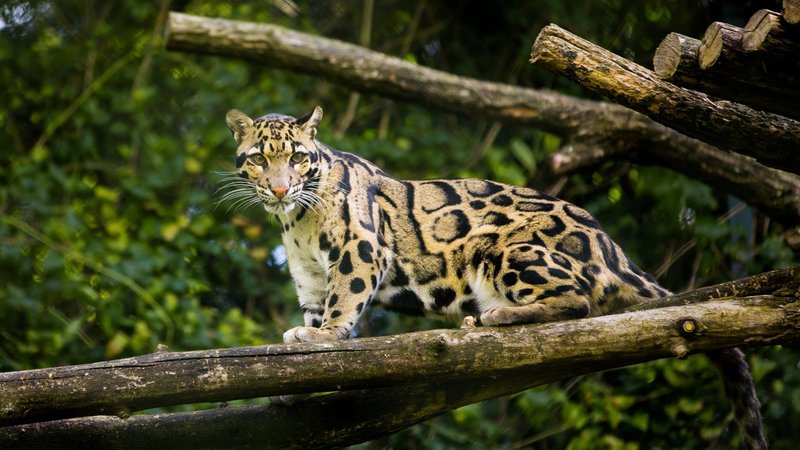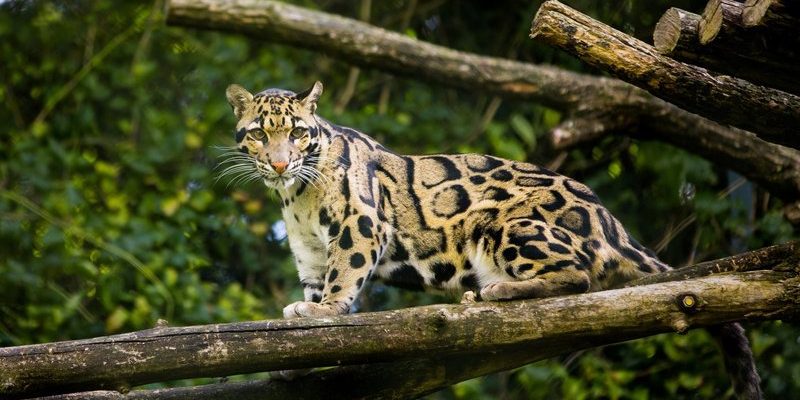
Clouded leopards are found in some of the most breathtaking yet less-explored landscapes in Southeast Asia. Their homes are often shrouded in mist, perched high in the trees, which can make them seem almost magical. So, where exactly do these leopards live? Let’s dive into their habitat and distribution to uncover the secrets of their world.
Clouded Leopard Habitat Overview
Clouded leopards thrive in forest environments, particularly in tropical and subtropical regions. They prefer dense, humid forests that offer plenty of cover and climbing opportunities. Think of these forests as a maze of trees, vines, and foliage where the leopards can stealthily navigate without being seen.
Their habitat ranges from lowland rainforests to mountainous areas, which means they have quite a versatile living arrangement. These cats are often found at elevations of up to 2,500 meters, especially in places like the Himalayan foothills. Forests provide not only shelter but also ample food sources, such as birds, deer, and various small mammals.
Here’s the thing: clouded leopards need trees, and lots of them! They are excellent climbers, using their powerful limbs to leap from tree to tree in search of prey. This arboreal lifestyle is a big part of what keeps them safe from larger predators.
Geographic Range of Clouded Leopards
Clouded leopards are primarily found in Southeast Asia, a region known for its incredible biodiversity. Their distribution stretches across several countries, including:
- Bhutan
- India (particularly the northeastern states)
- Myanmar
- Thailand
- Laos
- Vietnam
- Malaysia
- Indonesia (including the islands of Borneo and Sumatra)
These leopards have a relatively wide range, but they are also quite elusive. Their populations are primarily concentrated in forested areas where they can find the right mix of shelter and food. As you can imagine, logging and deforestation in these regions have put their existence at risk, making their habitats increasingly fragmented.
You might be wondering why their habitat matters so much. The truth is, when their forests are destroyed, clouded leopards lose not only their homes but also their sources of food, which can threaten their survival.
Types of Forests and Clouded Leopard Preferences
You know how some people love the beach while others prefer the mountains? Clouded leopards have specific preferences when it comes to their forests. They are especially fond of *primary forests*, which are older, untouched areas that have been relatively undisturbed by human activity. These places are like a treasure chest of biodiversity, filled with all sorts of plants and animals.
In addition to primary forests, clouded leopards also inhabit *secondary forests*, which are areas that have regrown after being logged or disturbed. While these forests can still provide the necessary cover and food, they may not be as ideal as primary forests. The more intact and healthy the forest, the better it is for clouded leopards and the other wildlife that depend on it.
Honestly, protecting these types of forests is crucial for the survival of clouded leopards. Every time a tree falls or a road is built, it can disrupt their way of life and push these beautiful creatures further toward extinction.
Clouded Leopards and Their Ecosystem
Clouded leopards play a significant role in their ecosystems, acting as both predator and prey. By keeping populations of smaller animals in check, they help maintain a balanced environment. Think of them as nature’s way of keeping everything in harmony. If clouded leopards disappear, it could lead to overpopulation of certain species, which can then affect the overall health of the forest.
One of the fascinating aspects of their role is their hunting technique. Clouded leopards are solitary hunters, sneaking up on their prey and using their keen eyesight and excellent climbing skills to strike. This unique hunting style is essential for the balance of their environment, as it ensures that various animal populations remain stable.
You might find it interesting that clouded leopards are also important for seed dispersal. As they consume fruits while hunting, they help distribute seeds throughout the forest, promoting new plant growth. This means that the leopards contribute not just to their immediate survival but to the health of their entire habitat.
Climate and Its Impact on Clouded Leopards
The tropical climates where clouded leopards live can be quite variable, with wet and dry seasons influencing their habitat. High rainfall creates the lush, dense forests these cats prefer, while prolonged dry periods can lead to changes in food availability. With climate change affecting weather patterns, the habitats of clouded leopards are becoming increasingly unstable.
Rising temperatures and extreme weather events can lead to habitat degradation. This not only affects the forest structure but can also change the distribution of prey. Species that clouded leopards rely on for food may shift to different areas, forcing these leopards to adapt quickly to changing circumstances.
Protecting clouded leopards means addressing climate change and its impacts on their habitats. Conservation efforts often aim to target areas that are most vulnerable, ensuring that these incredible creatures have safe spaces to thrive.
Conservation and Threats
Sadly, clouded leopards are listed as vulnerable due to habitat loss, poaching, and illegal wildlife trade. The demand for their beautiful pelts has unfortunately led to their decline in some areas. Conservation efforts are crucial to ensure these majestic animals don’t vanish from our forests forever.
Several organizations are working tirelessly to protect clouded leopards and their habitats. Conservation programs often focus on educating local communities, promoting sustainable practices, and establishing protected areas for wildlife. When communities are involved, they can develop a vested interest in preserving their natural surroundings.
You might wonder how you can help. Supporting wildlife conservation organizations, spreading awareness about clouded leopards, and advocating for sustainable practices can contribute to the ongoing protection of these amazing creatures and their habitats.
Final Thoughts on Clouded Leopards’ Habitat and Distribution
Understanding where clouded leopards live and why it matters is key to protecting these beautiful cats. These magnificent animals thrive in dense, humid forests found in Southeast Asia, where they play an essential role in their ecosystems. Their habitat faces numerous challenges, from deforestation to climate change, making it more important than ever to support conservation efforts.
Next time you hear about clouded leopards, think about the lush forests they call home and the delicate balance of nature that depends on their existence. By learning about them and sharing that knowledge, you can help ensure that future generations get to appreciate these unique creatures roaming their misty domains.

